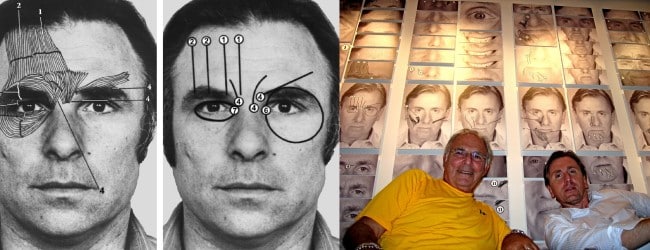
“HOW HAPPY AM I?”: the 16 possible types of Happiness
18 November 2014
Public Speaking and Nonverbal Communication – interview with Diego Ingrassia
10 December 2014FACIAL ACTION CODING SYSTEM (FACS): the starting tool for analysing every facial expression

Ekman, Friesen and Hager devoted themselves to writing the first atlas of the human face, the Facial Action Coding System (FACS)1, which includes a systematic description in words, photographs and films of how to measure facial movements in anatomical terms, breaking them down into individual units of movement (AU – Action Units).
The combinations potentially obtained by the simultaneous activation of several Action Units at the same time cover the entirety of all possible facial configurations a human being can assume (more than 10,000 combinations of facial movements at the same time).
The combinations potentially obtained by simultaneous activation of several Action Units at the same time cover the totality of all possible facial configurations a human being can assume (more than 10,000 in total).
In drafting their instrument, the authors studied in depth the works of Duchenne (1862)2 and Hjorstjo (1970)3, from whom they learnt:
– what facial conformation the face assumes in response to electrostimulation of individual facial muscles;
– the technique to move these muscles voluntarily and separately, and the effective way to describe them without interpretive inferences: FACS, in fact, does not use an inductive approach, but a descriptive one, so as to separate the inference (interpretation on the movement, e.g. “pout” and “aggressive frown”) from its objective description (what is visible; with respect to the examples before: “chin lift”, “bringing the chin up, contracting and lowering the eyebrows”), thus differentiating from other pre-existing4 facial coding systems.
Ekman (2011)5 describes in detail the work undertaken by those who observe and decompose expressions in the human face using FACS:
“[…] the encoder using FACS dissects each observed expression, breaking it down into the individual units (AUs – Action Units) that produce the movement. This is done by repeatedly viewing, slowing down and freezing certain recordings in order to determine which unit – or combination of units – can cause the observed expressive change. The tabulation of a facial expression consists of a list of the various units that produce it. The precise duration of each movement, its intensity and any bilateral asymmetries are also determined.”
A Certified FACS encoder is able to study every conformation assumed by the face, a useful starting point for the analysis of facial expressions and their decoding (whether they are emotional, used to illustrate and accompany speech, emblematically replacing words, or simple grimaces with no interpretable meaning).
The Facial Action Coding System is the most objective, valid and reliable method of coding facial expressions: these requirements are fundamental for those who practice and deal with behavioural research, and want to use a widely shared technical language (publications in major scientific journals) such as that of FACS.
The face, however, is only the first of the five channels of expression that those using Paul Ekman’s scientific method analyse. Those who are professionally trained in the methods ESaC andETaC, in fact, manage at the same time to analyse in the interlocutor:
– facial expressions;
– body language;
– the voice;
– verbal style;
– the verbal content (what it says);
Specialising only on one element of communication presents us with obvious limitations, since much of the information conveyed by our Central (and Autonomous) Nervous System manifests itself in the form of complex behaviours (verbal, para-verbal and non-verbal), covering the entire expressive area of the person. Just think of how much voice oscillations can vary with the onset of strong emotions; how much our gestures, the postures we assume, the visible neurophysiological reactions (pallor, redness, horripilation, etc.), if inserted into a communication, can be useful elements to investigate through questions.
How then to define whether a behaviour we observe is something atypical for the person emitting it, or is it in his or her usual behavioural repertoire? Drawing a precise baseline of our interlocutor – with rigour, method and appropriate contextualisation – allows us to make more complete, objective and reliable observations.
Paul Ekman himself reminds us that, to date, the human is the most reliable tool in the coding and interpretation of human behaviour (compared to automatic coding software, it is better able to trace the baseline of the person’s face and body language, as well as appropriately contextualise the communicative variables emitted). But even the human observer, without the proper training on how and what to look at, can only rely on instinct, sixth sense, chance or luck.
Using the scientific method, with a falsificationist approach as modus operandi, can allow us to make a difference: precision, scrupulous sifting of variables and formulation of alternative hypotheses, in order to achieve greater validity and reliability.
Cal Lightman (star of the television series ‘Lie to Me’ – FOX), unfortunately, is only a fictional character. But ‘his’ techniques, or rather Paul Ekman’s methods of investigation, are fortunately a concrete reality.
Diego Ingrassia
____________________
1 FACS Descriptions
- Ekman P., Friesen W. V. (1976), “Measuring Facial Movement”, Environmental Psychology and Nonverbal Behavior, 1(1), 56-75.
- Ekman P., Friesen W.V. (1978), Facial Action Coding System
- Ekman P., Friesen W. V., Hager J. C. (2002), “Manual” and “Investigator’s Guide”, In Facial Action Coding System, Published on CD ROM by Research Nexus division of Network Information Research Corporation.
.
.
.
2 Duchenne B. (1862), Mecanisme de la physionomie humaine ou analyse electrophysiologiçue de l’expression des passions, Paris: Bailliere.
.
3 Hjortsjo C. H. (1970), Man’s face and mimic language, Lund: Student-litteratur.
4 Alternative methods to FACS:
- Birdwhistell R. L. (1952), Introduction to Kinesics: An Annotation System for Analysis of Body Motion and Gesture, Washington, DC: Department of State, Foreign Service Institute.
- Blurton-Jones N. G. (1971), “Criteria for use in describing facial expressions in children”, Human Biology, 41, 365-413
- Brannigan C. R., Humphries D. A. (1972), ‘Human nonverbal behaviour, a means of communication’, In N. B. Blurton Jones (Ed.), Ethological studies of child behaviour, London: Cambridge University Press.
- Grant E. C. (1969), ‘Human facial expression’, Man, 4, 525-536
- McGrew W. C. (1972), An ethological study of children’s behaviour, New York: Academic Press.
- Nystrom M. (1974), ‘Neonatal facial-postural patterning during sleep: I. Description and reliability of observation’, Psychological Research Bulletin, 14, 1- 16.
- Young G., Decarie T. G. (1977), ‘An ethology-based catalogue of facial/vocal behaviours in infancy’, Animal Behavior, 25, 95-107.
- Ekman P., Friesen W. V., Tomkins S. S. (1971), “Facial Affect Scoring Technique – A First Validity Study”, Semiotics, 3, 37-58.
- Izard C. (1979), The maximally descriminative facial movement coding system [MAX.], Unpublished manuscript, Available from Instructional Resources Center, University of Delaware, Newark
- Frois-Wittmann J. (1930), “The judgment of facial expression”, Journal of Experimental Psychology, 13, 113-151.
- Fulcher, J. S. (1942), “”Voluntary” facial expression in blind and seeing children”,Archives of Psychology, 38. No. 272.
- Landis C. (1924), “Studies of Emotional Reactions, II., General Behavior and Facial Expression”, Journal of Comparative Psychology, 4(5): 447-509.
- Ermiane R., Gergerian E. (1978), Atlas of facial expressions; Album des expressions du visage, Paris: La Pensee Universelle.
.
.
.
.
.
.
.
.
.
.
.
5 Ekman P. (2011), The Seduction of Lies, Di Renzo Editore.


